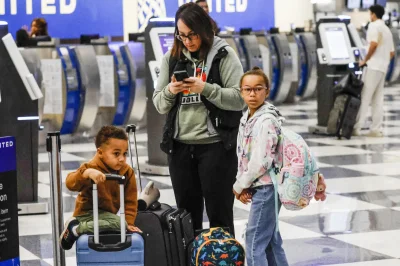Storms expected to affect post-holiday travel through Sunday

Nov. 27 (UPI) — Post-holiday travel plans might be impacted by potentially dangerous weather sweeping through much of the northern United States through the weekend, while rainstorms soak southern states.
Storm systems in the Pacific Northwest and the Great Lakes region are making road travel more dangerous and could trigger flight delays and cancellations during what the Federal Aviation Administration said is the busiest Thanksgiving holiday travel since before the COVID-19 pandemic.
More than 6 million travelers are expected to fly during the holiday travel period that officially runs from Tuesday evening through Sunday, NPR reported. Airports are operating at full capacity following the extended government shutdown.
Those traveling by plane on Thanksgiving day will mostly have good weather, but delays are expected in Buffalo, Cleveland, Syracuse, N.Y., Chicago and Seattle, according to the National Weather Service.
A winter storm made many roads impassable in North Dakota Tuesday night and into Wednesday, but those roads have reopened, including Interstates 94 and 29.
The storm system that caused those travel disruptions is moving east into the Great Lakes area, where a larger storm system is active and also moving eastward.
Seattle and other parts of the Pacific Northwest are seeing a storm system moving out of the area, but another is coming on its heels and could disrupt air and road travel through the weekend.
The storm system that is exiting the Pacific Northwest is moving into the northern Great Plains, which could bring more winter weather capable of making travel dangerous while causing flight delays and cancellations.
The NWS said travelers should expect delays or slower traffic on Saturday and Sunday, especially in the central United States on Saturday and in the east on Sunday.
Weather could affect flights at the Dallas-Fort Worth and Kansas City airports late Friday, and lake-effect snow could impact travel across the Great Lakes region.
Wrap-around snow showers also might affect travel in northern New England.
Further west, the NWS said Winter Storm Bellamy will expand as it exits Montana and moves into the Northern Plains. which will affect Black Friday travels in the Dakotas and south across the Missouri Valley.
The storm system will move into the Midwest by Saturday, where it could disrupt air travel in Chicago, Detroit, Minneapolis-St. Paul, Kansas City, St. Louis and as far south as Houston and the Dallas-Fort Worth area, where heavy rains and thunderstorms are anticipated.
The Chicago-O’Hare International Airport will be especially vulnerable to weather-caused flight disruptions, according to the NWS. Thunderstorms could cause localized flash flooding in the Dallas-Fort Worth area and Houston and the middle and lower Mississippi Valley.
On Sunday, the NWS said air travel might be affected in Atlanta, Boston, Denver, Detroit, New Orleans, New York City, Orlando, Philadelphia, Pittsburgh and the nation’s capital.
Winter Storm Bellamy is expected to affect northeastern states and bring mostly rainfall to the I-95 corridor, which could affect air travel throughout the area.
Some snowfall and lake-effect snow are likely in the Great Lakes, while rain showers and thunderstorms could impact the Southeast, from Virginia and the Carolinas to the northern Gulf Coast.
The central and southern Rocky Mountains also might see significant amounts of snowfall that could move into the High Plains, moving from Colorado and western Kansas into northern New Mexico, as well as parts of the Texas Panhandle and western Oklahoma.
Rain showers also might affect travel in areas are far west as Arizona, the NWS said on Thursday.

